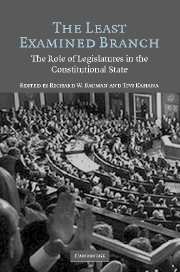Book contents
- Frontmatter
- Contents
- Foreword: Legislatures in the Constitutional State by Amy Gutmann
- Contributors
- New Ways of Looking at Old Institutions
- PART ONE LEGISLATURES AND DEMOCRATIC THEORY
- PART TWO LEGISLATING AND DELIBERATING IN THE DEMOCRATIC LEGISLATURE
- PART THREE CONSTITUTION MAKING BY LEGISLATURES: THE EXPLICIT VERSION
- PART FOUR CONSTITUTION MAKING BY LEGISLATURES: THE IMPLICIT VERSION
- PART FIVE CONSTITUTIONAL INTERPRETATION AND APPLICATION BY THE LEGISLATURE
- PART SIX IS LEGISLATIVE CONSTITUTIONALISM POSSIBLE?
- 20 Democratic Decision Making as the First Principle of Contemporary Constitutionalism
- 21 Legislative Constitutionalism in a System of Judicial Supremacy
- 22 Between Supremacy and Exclusivity
- 23 Legislatures as Rule-Followers
- 24 Popular Revolution or Popular Constitutionalism? Reflections on the Constitutional Politics of Quebec Secession
- PART SEVEN THE LEGISLATURE IN DIALOGUE: DOMESTIC AND INTERNATIONAL CONTEXTS
- Index
20 - Democratic Decision Making as the First Principle of Contemporary Constitutionalism
Published online by Cambridge University Press: 06 August 2009
- Frontmatter
- Contents
- Foreword: Legislatures in the Constitutional State by Amy Gutmann
- Contributors
- New Ways of Looking at Old Institutions
- PART ONE LEGISLATURES AND DEMOCRATIC THEORY
- PART TWO LEGISLATING AND DELIBERATING IN THE DEMOCRATIC LEGISLATURE
- PART THREE CONSTITUTION MAKING BY LEGISLATURES: THE EXPLICIT VERSION
- PART FOUR CONSTITUTION MAKING BY LEGISLATURES: THE IMPLICIT VERSION
- PART FIVE CONSTITUTIONAL INTERPRETATION AND APPLICATION BY THE LEGISLATURE
- PART SIX IS LEGISLATIVE CONSTITUTIONALISM POSSIBLE?
- 20 Democratic Decision Making as the First Principle of Contemporary Constitutionalism
- 21 Legislative Constitutionalism in a System of Judicial Supremacy
- 22 Between Supremacy and Exclusivity
- 23 Legislatures as Rule-Followers
- 24 Popular Revolution or Popular Constitutionalism? Reflections on the Constitutional Politics of Quebec Secession
- PART SEVEN THE LEGISLATURE IN DIALOGUE: DOMESTIC AND INTERNATIONAL CONTEXTS
- Index
Summary
Most scholars treat “constitutionalism” as though it were entirely defined by conceptions of negative liberty. In their view, constitutionalism is about limits on government in the interest of human rights and constitutional order. Gordon Schochet's introduction to the 1979 Nomos volume on the subject is representative: The fundamental premises of constitutionalism are “limited government and the rule of law (that governments exist only to serve specified ends and properly function only according to specified rules)”; or again, “the hallmark of modern constitutionalism is its reliance upon formal limitations on political power that are directly tied to popular sovereignty.” Few political theorists today, few constitutional lawyers, would dissent from this definition. It shapes how we conceive of the domain of constitutional law, the internal values of that law, and the relationships between the various components of the state. Constitutional law is about constraining the state.
But constitutions are not primarily about limiting government. Their first role is to constitute government: to specify the processes by which public decisions are made. Any sensible approach to constitutionalism has to take seriously their role in defining the public voice – indeed in creating several complementary or competing public voices, for especially in a federal system, but also in nominally unitary systems, those institutional voices are plural. This is a positive role, a role that enables public action, not one that is adequately captured through the concept of limits. And in defining the public voice, democratic participation is fundamental.
- Type
- Chapter
- Information
- The Least Examined BranchThe Role of Legislatures in the Constitutional State, pp. 411 - 430Publisher: Cambridge University PressPrint publication year: 2006
- 2
- Cited by



